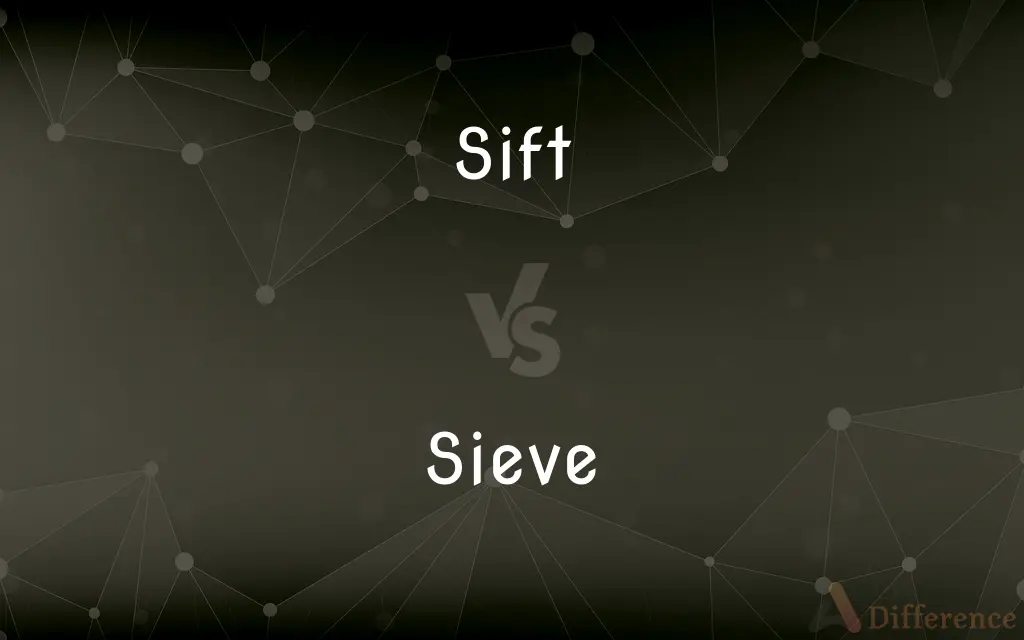Sift vs. Sieve — What's the Difference?
Edited by Tayyaba Rehman — By Fiza Rafique — Updated on March 9, 2024
Sifting involves passing a substance through a sieve to remove lumps or large particles, emphasizing the process, while sieve refers to the tool used for this process, emphasizing the instrument.

Difference Between Sift and Sieve
Table of Contents
ADVERTISEMENT
Key Differences
Sifting is the action or process of passing a dry substance through a sieve to break up lumps and remove finer particles from coarser ones. This process is commonly used in cooking and industrial applications to ensure uniformity and improve texture. On the other hand, a sieve is a device consisting of a mesh held in a frame, used for separating coarser from finer particles. It's the tool that facilitates the sifting process, available in various mesh sizes to suit different materials and purposes.
While sifting is an action that requires a sieve or similar device, the term "sieve" can also be used more broadly to refer to any tool or equipment that performs the function of separating materials based on size. Thus, while all sifting involves using a sieve, sieves can be used for a variety of other purposes beyond sifting, such as straining liquids or even sorting larger objects in industrial processes.
Sifting is often a preparatory step in cooking, especially in baking, to aerate flour and ensure that it is free of impurities and lumps, which can affect the texture and appearance of the final product. In contrast, sieves are used not only in cooking but also in scientific research, construction, and agriculture, highlighting the versatility of the tool itself.
The effectiveness of sifting depends on the mesh size of the sieve used, the material being sifted, and the technique of the person performing the sifting. This makes the choice of sieve critical for the desired outcome. Conversely, sieves must be selected based on the specific needs of the task at hand, whether it's to achieve a fine powder for culinary use or to separate materials of different sizes for construction purposes.
Sifting and sieve are closely related concepts, with sifting being the process and the sieve being the tool that enables this process. Both play crucial roles in various fields, from cooking and baking to industrial manufacturing and scientific research.
ADVERTISEMENT
Comparison Chart
Definition
The process of passing a substance through a sieve to remove lumps or separate particles.
A tool or device with a mesh used to separate coarser particles from finer ones.
Primary Use
To aerate and remove impurities from dry ingredients, especially in cooking.
To strain, sift, or separate materials based on size in various applications.
Context
Commonly used in cooking and baking, and in some industrial applications.
Used across cooking, baking, scientific research, construction, and agriculture.
Focus
Emphasizes the action or process.
Emphasizes the tool or instrument.
Versatility
Specifically refers to the process of separation or aeration of particles.
Refers to a wide range of separation tasks, including but not limited to sifting.
Compare with Definitions
Sift
To aerate and refine dry ingredients.
The chef sifted the flour before making the cake batter.
Sieve
A mesh tool for straining or sifting.
She used a fine sieve to strain the broth.
Sift
To process or examine thoroughly.
Sifting the evidence was crucial for the investigation.
Sieve
An item used in gardening to remove debris.
The gardener used a sieve to separate compost from larger waste.
Sift
To separate finer particles from coarser ones.
Archaeologists sifted the soil to find small artifacts.
Sieve
An instrument in baking for aerating flour.
A sieve is essential for getting lump-free flour in recipes.
Sift
To clarify or refine information.
The researcher sifted through data to identify relevant statistics.
Sieve
A device to separate materials by size.
The construction workers used a sieve to sort the gravel.
Sift
To remove lumps from a powdered substance.
Sifting the cocoa powder ensures a smooth chocolate sauce.
Sieve
A tool for scientific research to classify particles.
Scientists use sieves to analyze soil samples.
Sift
To put (flour, for example) through a sieve in order to separate the fine from the coarse particles.
Sieve
A sieve, fine mesh strainer, or sift, is a device for separating wanted elements from unwanted material or for characterizing the particle size distribution of a sample, using a screen such as a woven mesh or net or perforated sheet material. The word "sift" derives from "sieve".
Sift
To distinguish as if separating with a sieve
Sifted the candidates for the job.
Sieve
A utensil of wire mesh or closely perforated metal or plastic, used for straining, sifting, ricing, or puréeing.
Sift
To apply by scattering through a sieve
Sift sugar on a dessert.
Sieve
To pass through a sieve.
Sift
To examine and sort carefully
Sift the evidence.
Sieve
To use a sieve; sift.
Sift
To make use of a sieve.
Sieve
A device with a mesh bottom to separate, in a granular material, larger particles from smaller ones, or to separate solid objects from a liquid.
Use the sieve to get the pasta from the water.
Sift
To pass through a sieve
A meal that sifts easily.
Sieve
A process, physical or abstract, that arrives at a final result by filtering out unwanted pieces of input from a larger starting set of input.
Given a list of consecutive numbers starting at 1, the Sieve of Eratosthenes algorithm will find all of the prime numbers.
Sift
To make a careful examination
Sifted through back issues of the magazine.
Sieve
(obsolete) A kind of coarse basket.
Sift
To sieve or strain (something).
Sieve
(colloquial) A person, or their mind, that cannot remember things or is unable to keep secrets.
Sift
To separate or scatter (things) as if by sieving.
Sieve
An intern who lets too many non-serious cases into the emergency room.
Sift
To examine (something) carefully.
Sieve
(category theory) A collection of morphisms in a category whose codomain is a certain fixed object of that category, which collection is closed under precomposition by any morphism in the category.
Sift
(archaic or old-fashioned) To scrutinise (someone or something) carefully so as to find the truth.
Sieve
To strain, sift or sort using a sieve.
Sift
To carefully go through a set of objects, or a collection of information, in order to find something.
Sieve
(sports) To concede; let in
Sift
To move data records up in memory to make space to insert further records.
Sieve
A utensil for separating the finer and coarser parts of a pulverized or granulated substance from each other. It consist of a vessel, usually shallow, with the bottom perforated, or made of hair, wire, or the like, woven in meshes.
Sift
To separate with a sieve, as the fine part of a substance from the coarse; as, to sift meal or flour; to sift powder; to sift sand or lime.
Sieve
A kind of coarse basket.
Sift
To separate or part as if with a sieve.
When yellow sands are sifted from below,The glittering billows give a golden show.
Sieve
A strainer for separating lumps from powdered material or grading particles
Sift
To examine critically or minutely; to scrutinize.
Sifting the very utmost sentence and syllable.
Opportunity I here have hadTo try thee, sift thee.
Let him but narrowly sift his ideas.
Sieve
Examine in order to test suitability;
Screen these samples
Screen the job applicants
Sift
Move as if through a sieve;
The soldiers sifted through the woods
Sieve
Check and sort carefully;
Sift the information
Sift
Separate by passing through a sieve or other straining device to separate out coarser elements;
Sift the flour
Sieve
Separate by passing through a sieve or other straining device to separate out coarser elements;
Sift the flour
Sift
Check and sort carefully;
Sift the information
Sieve
Distinguish and separate out;
Sift through the job candidates
Sift
Distinguish and separate out;
Sift through the job candidates
Common Curiosities
What are the types of sieves?
Sieves vary by mesh size, material (metal, plastic), and shape, tailored for specific tasks from fine sifting to straining large particles.
What is the main purpose of sifting flour?
Sifting flour aerates it, removes impurities, and ensures it's free of lumps for a smoother, more uniform texture in baking.
How do you clean a sieve properly?
Rinse under running water to remove particles, then wash with soap and a brush if needed, and dry thoroughly to prevent rust.
Can you use something other than a sieve for sifting?
While a sieve is the standard tool, alternatives like strainers or even a fork for small amounts can be used for sifting.
How does sifting affect baking outcomes?
Sifting improves the texture of baked goods by aerating the flour, ensuring even mixing, and preventing clumps.
Can sieving affect the flavor of food?
While sieving primarily affects texture, it can indirectly enhance flavor by ensuring even distribution of ingredients.
What materials can be sifted?
Besides flour, sugar, cocoa, spices, soil, sand, and powdered chemicals are among materials commonly sifted.
How often should dry ingredients be sifted?
It depends on the recipe and desired texture; some may require sifting before use to ensure consistency and lightness.
Can sifting be automated in industrial processes?
Yes, many industries use automated sifting machines to process large quantities of materials efficiently.
What is the difference between a sieve and a colander?
A sieve has a finer mesh for sifting or straining small particles, while a colander has larger holes, mainly for draining liquids from foods.
Do all kitchens need a sieve?
While not mandatory, a sieve is a highly useful tool in the kitchen for baking, cooking, and preparing ingredients.
Why is the size of the sieve's mesh important?
The mesh size determines the fineness of the material after sifting, affecting texture and consistency in cooking and other applications.
Is sifting necessary for all baking recipes?
Not all, but many recipes, especially those requiring fine textures like cakes and pastries, benefit from sifting to improve flour quality.
How does inspection differ from sifting in manufacturing?
Inspection evaluates overall product quality and compliance, while sifting is a specific process to refine or separate materials.
Why might a scientist use a sieve in research?
Sieves are used in research to classify materials, study soil composition, or analyze particulate sizes in various scientific fields.
Share Your Discovery

Previous Comparison
Directive vs. Order
Next Comparison
Alphanumeric vs. NumericAuthor Spotlight
Written by
Fiza RafiqueFiza Rafique is a skilled content writer at AskDifference.com, where she meticulously refines and enhances written pieces. Drawing from her vast editorial expertise, Fiza ensures clarity, accuracy, and precision in every article. Passionate about language, she continually seeks to elevate the quality of content for readers worldwide.
Edited by
Tayyaba RehmanTayyaba Rehman is a distinguished writer, currently serving as a primary contributor to askdifference.com. As a researcher in semantics and etymology, Tayyaba's passion for the complexity of languages and their distinctions has found a perfect home on the platform. Tayyaba delves into the intricacies of language, distinguishing between commonly confused words and phrases, thereby providing clarity for readers worldwide.















































